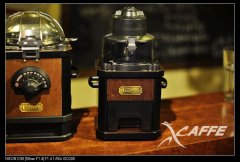Basic knowledge of boutique coffee classification of roasting degree of coffee

New England baking: light brown, bean flour dry.
American Roast: Medium brown, bean flour dry.
Viennese: Medium dark brown with a few drops of coffee fat on the beans.
French Roast: Moderately dark brown bean flour with a thin coffee fat.
Espresso Roast: Dark brown, beans may have only a thin layer of coffee fat or a thick layer of coffee fat depending on the degree of roasting.
Italian Bake: Dark brown, close to black, the bean flour is shiny, most bakers bake to this extent is the darkest.
Dark French or Spanish: A very dark brown that goes black quickly and is extremely oily.
Traditional US-defined baking pattern names
There is also a naming convention for baking patterns that has been used in the United States since the 19th century, roughly in the following order:
Cinnamon: Very light brown.
Light: The lightest degree of American baking.
Medium baking.
Medium High: American baking lasts the longest to this point.
City high: A little deeper than the usual American roast.
Full City Roast: Deeper than the former, the bean noodles sometimes have a few drops of coffee fat.
Dark Roast: Dark brown, bean-flour glossy, similar to the regional classification of Espresso or French Roast.
Heavy: Very dark brown, beancurd glossy, similar to Italian baking.
Among these names, the only one that is still frequently used today is the name Deep City Roast, a baking pattern that is located a little deeper than the American Roast of the mid-20th century.
Filling in the gaps in traditional baking pattern classification with numbers: caramelization degree classification and SCAA's color scale discrimination system
After looking at the previous two categories of baking pattern classification, are you confused? Yes, in order to solve the problem caused by these two, the Specialty Coffee Association of America (SCAA) specially developed a set of auxiliary tools, so that we can use more accurate instruments to determine the degree of roasting color.
There are eight references in this set of aids, no names, only numbers, which correspond exactly to eight carefully designed baking depth codes. A sample coffee bean is roasted, ground to a fine powder and poured into a special tray before it is sent to a measuring instrument loaded with chemical index or caramelization measurement standards to begin comparison with color scales. The depth of these coffee beans is classified as the closest to one of the "Agtron". The color scale corresponds to caramelization numbers ranging from #95(lightest baking depth),#85(lightest baking depth), to #25(generally darkest baking depth).
Important Notice :
前街咖啡 FrontStreet Coffee has moved to new addredd:
FrontStreet Coffee Address: 315,Donghua East Road,GuangZhou
Tel:020 38364473
- Prev

Introduction to roasting beans for boutique coffee the process of roasting on hand net
A few days ago, Meng long came to Hao Fang Coffee Shop to buy coffee beans. He is an expert at roasting at home. There are more and more friends like him, and Uncle Dou is now starting to pack raw beans into small packets to share with his baked friends. There are only two varieties, but there will be more and more. It is a pleasure to discuss with friends who play baking. If your friends who play baking at home buy small ones.
- Next

Grinding effect of coffee powder of South Korea ICOFFEE coffee grinder
ICOFFEE N901CR series also has a bean grinder, feel very matching and curious into two to see the performance is still retro style ICOFFEE N901CR the same series of bean grinder, this machine is also a wonderful work in the bean grinder. It is gratifying to note that the uniformity of the grinding is very good, and there is almost no flour (the very fine residual powder that many players taboo).
Related
- Beginners will see the "Coffee pull flower" guide!
- What is the difference between ice blog purified milk and ordinary milk coffee?
- Why is the Philippines the largest producer of crops in Liberia?
- For coffee extraction, should the fine powder be retained?
- How does extracted espresso fill pressed powder? How much strength does it take to press the powder?
- How to make jasmine cold extract coffee? Is the jasmine + latte good?
- Will this little toy really make the coffee taste better? How does Lily Drip affect coffee extraction?
- Will the action of slapping the filter cup also affect coffee extraction?
- What's the difference between powder-to-water ratio and powder-to-liquid ratio?
- What is the Ethiopian local species? What does it have to do with Heirloom native species?

